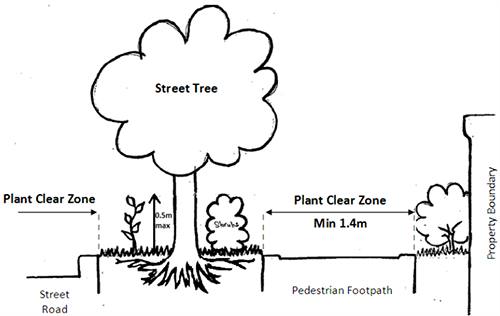Planting on Nature Strips Guidelines
Regulations for nature strip modification
Monash residents and property owners are allowed to modify nature strips, if the following guidelines are met and nature strips are kept safe and accessible for community and service authorities.
If you live on an arterial road, you may not be able to plant on the nature strip. Please contact the Engineering Department at Council on 9518 3555 to discuss before you submit an application.
Planting Guidelines
Our Nature Strip Planting guidelines aim to help you plant with confidence and create a beautiful and safe nature strip. The following list highlights the key things to keep in mind and follow, when planning and maintaining your nature strip.
What to do and what is permitted
| Yes |
Apply for a permit
Before starting any landscaping or excavation, make sure to apply for a Nature Strip Planting Permit from Council.
|
| Yes |
Keep It Low and Lovely
Choose plants that grow no taller than 50cm to maintain visibility and safety for pedestrians and drivers.
|
| Yes |
Use Permeable (Porous) Surfaces
Choose native bush mulch as a ground cover as it supports healthy plant growth.
For practical areas, such as bin collection zones, pathways or strip edges, granitic sand or gravel can be a good option to use, to allow water to go through.
|
| Yes |
Choose the Right Plants
Use indigenous, native, or approved exotic species from the Council’s recommended plant list.
|
| Yes |
Leave Room for Access
Maintain a 1.4m clear zone for footpaths and ensure space for waste bins and vehicle access.
|
| Yes |
Keep It Safe
Ensure your nature strip is safe for everyone — no tripping hazards, sharp objects, or obstructed views.
|
| Yes |
Join the Community Project
Apply to join the Nature Strip Planting Project and receive 50 free indigenous seedlings and a $50 garden voucher!
|
What is NOT permitted and should be avoided
| No |
Skip the Permit
Don’t start planting or digging without a permit, except for simply renewing grass.
|
| No |
Use Hard or Non-Permeable (Non-Porous) Surfaces
Synthetic turf, concrete, bricks and pavers are not permitted on nature strips. These can cause environmental, accessibility and drainage issues.
Loose or raised objects like logs, rocks and pebbles are not permitted as they can cause tripping and safety hazards.
|
| No |
Plant Tall or Invasive Species
No trees or plants over 50cm, and avoid edible, toxic, or invasive species.
|
| No |
Install Permanent Fixtures
No irrigation systems, garden edging, or private lighting on the nature strip.
|
| No |
Block Access to Infrastructure
Keep fire hydrants, manholes poles and benches visible and accessible for service authorities and maintenance.
|
| No |
Raise or Lower Ground Levels Too Much
Ensure soil or mulch is no more than 4cm higher or lower than the footpath.
|

Creating community and service-friendly nature strips
Council assets, service infrastructure and street furniture on a nature strip must be visible and accessible. This includes fire hydrants, manholes, benches and poles. From time to time, City of Monash or other service authorities may need to perform essential service, maintenance or repairs in or around nature strips. Service personnel must be able to safely enter and exit nature strips and properties when conducting works.
If works do need to be completed, some plants may be damaged or taken out as part of the works. Plants can be replaced with topsoil and grass seeds. You can discuss options with the involved service authority to save plants where possible, or leave just top soil after works to reinstate nature strip with plantings.
It is important to remember that plantings should not get in the way of vehicles accessing properties or pedestrians accessing parked vehicles. There needs to be enough space on the nature strip for waste collection – rubbish, recycling and food and garden waste bins, as well as hard rubbish.